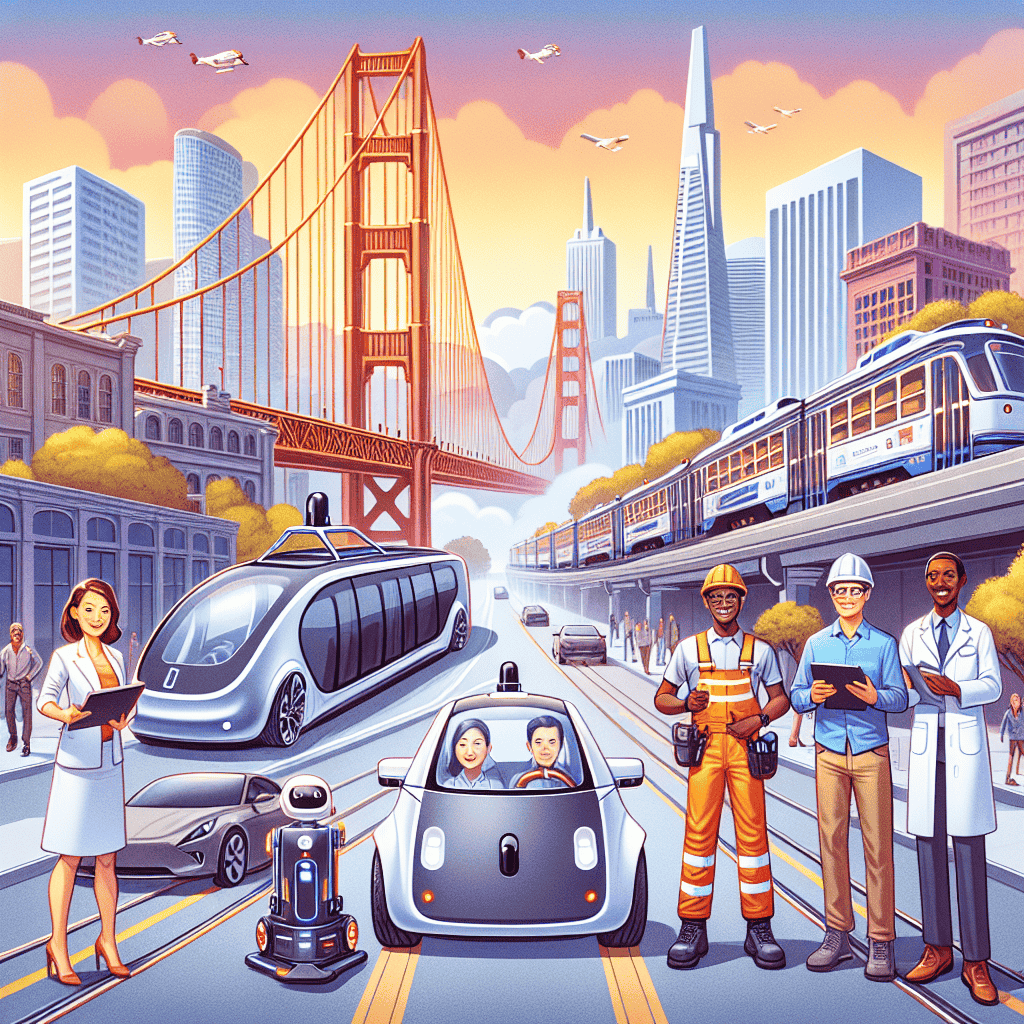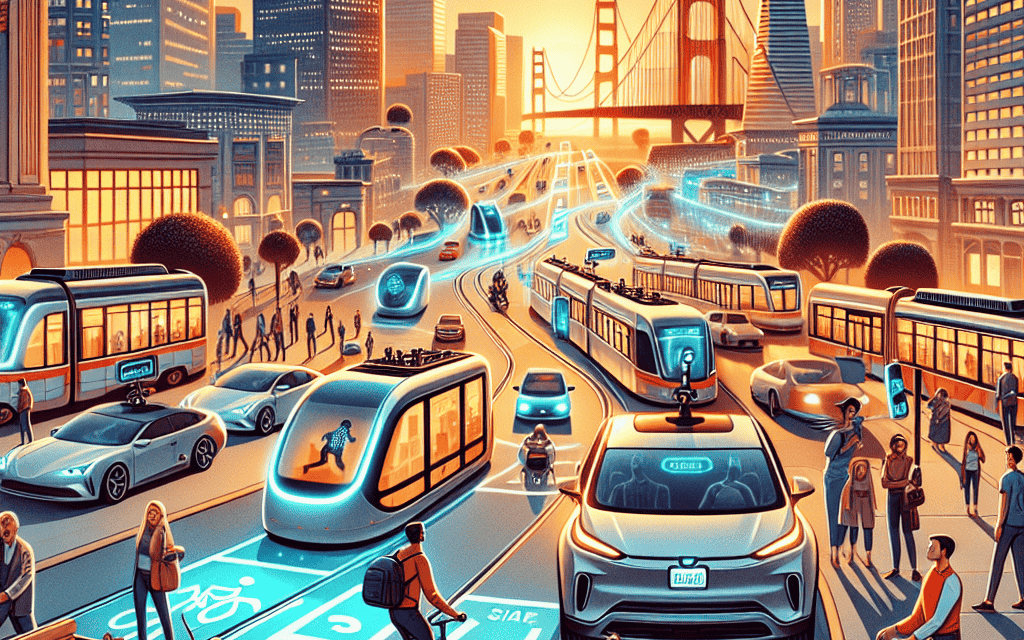“Driving Forward: San Francisco’s Path to Autonomous Acceptance”
Introduction
San Francisco, a city renowned for its innovation and technological prowess, stands at the forefront of a transportation revolution with the advent of autonomous vehicles. As urban landscapes worldwide grapple with the challenges and opportunities presented by self-driving technology, San Francisco’s journey to acceptance offers a compelling narrative of adaptation and progress. The city’s unique topography, bustling streets, and diverse population create a dynamic testing ground for autonomous vehicles, pushing the boundaries of what is possible in urban mobility. Through a combination of regulatory foresight, public-private partnerships, and community engagement, San Francisco is navigating the complexities of integrating autonomous vehicles into its transportation ecosystem. This journey not only highlights the potential for enhanced safety, efficiency, and accessibility but also underscores the importance of addressing societal concerns and ensuring equitable access to this transformative technology. As San Francisco embraces the future of transportation, it sets a precedent for cities around the world, demonstrating how innovation can be harmoniously woven into the fabric of urban life.
The Evolution Of Autonomous Vehicles In San Francisco
San Francisco, a city renowned for its technological innovation and progressive mindset, has become a focal point in the evolution of autonomous vehicles. The journey towards acceptance of these self-driving cars has been marked by a series of developments that reflect both the challenges and opportunities inherent in integrating such advanced technology into urban life. As the city navigates this transformative period, it is essential to understand the various factors that have influenced the trajectory of autonomous vehicles in this vibrant metropolis.
Initially, the introduction of autonomous vehicles in San Francisco was met with a mix of excitement and skepticism. The promise of reduced traffic congestion, lower emissions, and enhanced road safety was appealing to many residents and city planners. However, concerns about the reliability of the technology, potential job losses in the transportation sector, and the ethical implications of machine decision-making posed significant hurdles. Despite these challenges, the city has made considerable strides in addressing these issues through a combination of regulatory frameworks, public-private partnerships, and community engagement.
One of the pivotal moments in San Francisco’s journey towards embracing autonomous vehicles was the establishment of a regulatory environment conducive to innovation. The California Department of Motor Vehicles played a crucial role by developing guidelines that allowed for the testing and deployment of autonomous vehicles on public roads. These regulations provided a structured approach to ensure safety while encouraging technological advancement. Moreover, the city’s collaboration with tech companies and academic institutions has fostered an ecosystem that supports research and development in autonomous vehicle technology.
In addition to regulatory measures, public perception has been a critical factor in the acceptance of autonomous vehicles. To address concerns and build trust, companies involved in the development of self-driving cars have engaged in extensive outreach efforts. These initiatives include public demonstrations, educational campaigns, and partnerships with local organizations to highlight the benefits of autonomous vehicles. By fostering transparency and open communication, these efforts have gradually shifted public opinion towards a more favorable view of the technology.
Furthermore, the integration of autonomous vehicles into San Francisco’s transportation infrastructure has been facilitated by advancements in related technologies. The development of sophisticated sensors, machine learning algorithms, and high-definition mapping systems has significantly improved the performance and reliability of self-driving cars. These technological breakthroughs have not only enhanced the capabilities of autonomous vehicles but have also addressed many of the safety concerns that initially hindered their acceptance.
As San Francisco continues to embrace autonomous vehicles, the city is also exploring the broader implications of this technology on urban planning and mobility. The potential for autonomous vehicles to reshape public transportation systems, reduce parking requirements, and influence land use patterns presents both opportunities and challenges for city planners. By proactively considering these factors, San Francisco aims to create a sustainable and efficient transportation network that leverages the benefits of autonomous vehicles while mitigating potential drawbacks.
In conclusion, the evolution of autonomous vehicles in San Francisco is a testament to the city’s commitment to innovation and progress. Through a combination of regulatory support, public engagement, and technological advancements, San Francisco has positioned itself as a leader in the adoption of self-driving cars. As the city continues to navigate this complex landscape, its experiences offer valuable insights for other urban centers seeking to integrate autonomous vehicles into their transportation systems. Ultimately, San Francisco’s journey towards acceptance of autonomous vehicles underscores the importance of balancing innovation with thoughtful planning and community involvement.
Overcoming Challenges: San Francisco’s Path To Autonomous Vehicle Integration
San Francisco, a city renowned for its innovation and technological advancements, stands at the forefront of integrating autonomous vehicles into its urban landscape. The journey toward acceptance of these self-driving cars, however, has not been without its challenges. As the city navigates this complex transition, it becomes essential to understand the multifaceted obstacles and the strategies employed to overcome them.
Initially, one of the primary challenges faced by San Francisco was the public’s apprehension toward autonomous vehicles. Concerns about safety, reliability, and the potential for accidents were prevalent among residents. To address these fears, city officials and technology companies embarked on extensive public awareness campaigns. These initiatives aimed to educate the public about the technology behind autonomous vehicles, emphasizing their potential to reduce human error and enhance road safety. By fostering a dialogue between developers and the community, San Francisco sought to build trust and dispel myths surrounding self-driving technology.
In addition to public perception, regulatory hurdles posed significant challenges to the integration of autonomous vehicles. The existing legal framework was not equipped to accommodate the unique requirements of self-driving cars, necessitating a comprehensive overhaul of traffic laws and regulations. San Francisco worked closely with state and federal authorities to develop a regulatory environment conducive to innovation while ensuring public safety. This collaborative approach facilitated the creation of guidelines that balanced technological advancement with the need for stringent safety standards.
Moreover, the city’s infrastructure required substantial modifications to support the seamless operation of autonomous vehicles. San Francisco’s hilly terrain and complex road networks presented unique challenges for self-driving technology. To address these issues, significant investments were made in upgrading road infrastructure, including the installation of advanced sensors and communication systems. These enhancements enabled autonomous vehicles to navigate the city’s streets more effectively, thereby improving their overall performance and reliability.
Another critical aspect of San Francisco’s journey toward autonomous vehicle integration was addressing the potential impact on employment. The rise of self-driving technology raised concerns about job displacement, particularly among those employed in the transportation sector. To mitigate these effects, the city implemented workforce development programs aimed at retraining individuals for new roles within the evolving transportation ecosystem. By focusing on reskilling and upskilling, San Francisco sought to ensure that its workforce remained adaptable and resilient in the face of technological change.
Furthermore, collaboration between technology companies and local government played a pivotal role in overcoming the challenges associated with autonomous vehicle integration. By fostering partnerships, San Francisco was able to leverage the expertise and resources of private enterprises while ensuring that public interests were safeguarded. This collaborative model facilitated the sharing of data and insights, enabling continuous improvement in the development and deployment of autonomous vehicles.
In conclusion, San Francisco’s journey to embrace autonomous vehicles has been marked by a series of challenges that required innovative solutions and collaborative efforts. Through public education, regulatory adaptation, infrastructure enhancement, workforce development, and strategic partnerships, the city has made significant strides toward integrating self-driving technology into its urban fabric. As San Francisco continues to navigate this transformative period, its experiences serve as a valuable blueprint for other cities seeking to embrace the future of transportation. The path to acceptance may be complex, but with determination and foresight, San Francisco is paving the way for a new era of mobility.
Public Perception And Acceptance Of Self-Driving Cars In San Francisco
San Francisco, a city renowned for its technological innovation and forward-thinking culture, has become a focal point in the development and deployment of autonomous vehicles. As these self-driving cars navigate the city’s iconic streets, the public’s perception and acceptance of this technology have become crucial factors in determining its future success. Initially, the introduction of autonomous vehicles in San Francisco was met with a mix of excitement and skepticism. Enthusiasts hailed the technology as a revolutionary step towards reducing traffic congestion and enhancing road safety. However, concerns about the reliability of these vehicles and their potential impact on employment in the transportation sector tempered this enthusiasm.
Over time, as autonomous vehicles became a more common sight on the streets, public perception began to shift. One of the key factors contributing to this change was the increased visibility of successful pilot programs and partnerships between technology companies and local government. These initiatives demonstrated the potential benefits of self-driving cars, such as improved traffic flow and reduced emissions, which resonated with the environmentally conscious residents of San Francisco. Moreover, the city’s commitment to rigorous safety standards and transparent communication helped alleviate some of the initial fears surrounding the technology.
In addition to these efforts, the role of media coverage cannot be understated. Positive stories highlighting the successful integration of autonomous vehicles into the city’s transportation network played a significant role in shaping public opinion. As residents read about the technology’s potential to reduce accidents caused by human error, they began to view self-driving cars as a viable solution to some of the city’s most pressing transportation challenges. Furthermore, testimonials from early adopters who experienced the convenience and efficiency of autonomous vehicles firsthand contributed to a growing sense of trust in the technology.
Despite these advancements, challenges remain in achieving widespread acceptance of autonomous vehicles in San Francisco. Concerns about data privacy and cybersecurity persist, as residents worry about the potential misuse of personal information collected by these vehicles. Additionally, the ethical implications of programming decisions in life-and-death scenarios continue to spark debate among ethicists and technologists alike. Addressing these concerns requires ongoing dialogue between technology developers, policymakers, and the public to ensure that the deployment of autonomous vehicles aligns with societal values and expectations.
Moreover, the transition to a future dominated by self-driving cars necessitates significant infrastructure changes. San Francisco’s narrow streets and complex traffic patterns present unique challenges that require careful planning and investment. The city’s ability to adapt its infrastructure to accommodate autonomous vehicles will play a crucial role in determining the technology’s long-term success and acceptance.
In conclusion, the journey towards embracing autonomous vehicles in San Francisco is a multifaceted process that involves balancing technological innovation with public concerns. While significant progress has been made in shifting public perception towards acceptance, ongoing efforts are needed to address the remaining challenges. By fostering collaboration between stakeholders and maintaining a focus on safety, transparency, and ethical considerations, San Francisco can continue to lead the way in integrating autonomous vehicles into its transportation ecosystem. As the city navigates this transformative period, its experience may serve as a valuable blueprint for other urban centers seeking to embrace the future of transportation.
Regulatory Frameworks: How San Francisco Is Paving The Way For Autonomous Vehicles

San Francisco, a city renowned for its technological innovation and forward-thinking ethos, is at the forefront of integrating autonomous vehicles into its urban landscape. As the world inches closer to a future where self-driving cars are commonplace, San Francisco’s regulatory frameworks are playing a pivotal role in shaping this transition. The city’s journey towards embracing autonomous vehicles is marked by a series of strategic regulatory measures designed to ensure safety, promote innovation, and address public concerns.
Initially, the introduction of autonomous vehicles in San Francisco was met with a mix of excitement and apprehension. The potential benefits of reduced traffic congestion, lower emissions, and enhanced road safety were clear. However, these advantages were tempered by concerns over safety, job displacement, and the readiness of existing infrastructure. Recognizing these challenges, San Francisco’s regulatory bodies have adopted a proactive approach, crafting policies that balance innovation with public safety.
One of the key elements of San Francisco’s regulatory framework is the establishment of pilot programs that allow for the controlled testing of autonomous vehicles on public roads. These programs are designed to gather data on vehicle performance, safety, and interaction with human drivers and pedestrians. By allowing companies to test their vehicles in real-world conditions, the city can identify potential issues and refine regulations accordingly. This iterative process ensures that regulations evolve in tandem with technological advancements, fostering an environment conducive to innovation.
Moreover, San Francisco has implemented stringent safety standards for autonomous vehicles operating within its jurisdiction. These standards mandate rigorous testing and certification processes, ensuring that only vehicles meeting the highest safety criteria are permitted on the roads. By prioritizing safety, the city aims to build public trust in autonomous technology, a crucial factor in its widespread acceptance.
In addition to safety, San Francisco’s regulatory framework addresses the ethical and social implications of autonomous vehicles. The city has initiated discussions on data privacy, cybersecurity, and the ethical programming of autonomous systems. These conversations are essential in establishing guidelines that protect individual rights while enabling technological progress. By engaging with stakeholders from various sectors, including technology companies, policymakers, and the public, San Francisco is fostering a collaborative approach to regulation.
Furthermore, the city is investing in infrastructure improvements to accommodate autonomous vehicles. This includes upgrading road signage, traffic signals, and communication networks to facilitate seamless interaction between autonomous vehicles and the urban environment. By modernizing infrastructure, San Francisco is laying the groundwork for a future where autonomous vehicles can operate efficiently and safely.
As San Francisco continues to refine its regulatory frameworks, the city serves as a model for other urban centers grappling with the integration of autonomous vehicles. The lessons learned from San Francisco’s experience can inform global efforts to develop policies that support innovation while addressing societal concerns. By embracing a comprehensive and adaptive regulatory approach, San Francisco is not only paving the way for autonomous vehicles but also setting a precedent for responsible technological advancement.
In conclusion, San Francisco’s journey to acceptance of autonomous vehicles is characterized by a thoughtful and balanced regulatory strategy. By prioritizing safety, fostering innovation, and addressing ethical considerations, the city is creating a framework that supports the successful integration of autonomous vehicles into its urban fabric. As the world watches San Francisco’s progress, the city stands as a testament to the potential of regulatory foresight in shaping a future where technology and society coexist harmoniously.
The Impact Of Autonomous Vehicles On San Francisco’s Urban Landscape
San Francisco, a city renowned for its iconic Golden Gate Bridge and steep, winding streets, is now at the forefront of a technological revolution that promises to reshape its urban landscape: the integration of autonomous vehicles. As these self-driving cars become increasingly prevalent, their impact on the city’s infrastructure, economy, and daily life is becoming more pronounced. The journey to acceptance, however, is not without its challenges and opportunities.
To begin with, the introduction of autonomous vehicles in San Francisco has necessitated significant changes in the city’s infrastructure. The existing roadways, designed for human drivers, are being adapted to accommodate the unique needs of self-driving cars. This includes the installation of advanced sensors and communication systems that allow these vehicles to navigate safely and efficiently. Moreover, the city is exploring the redesign of intersections and traffic signals to optimize the flow of autonomous traffic. These infrastructural modifications are essential to ensure that the integration of autonomous vehicles enhances, rather than disrupts, the urban environment.
In addition to infrastructure, the economic implications of autonomous vehicles are profound. On one hand, the technology promises to boost the local economy by attracting tech companies and creating new jobs in the field of vehicle maintenance and software development. On the other hand, there is concern about the potential displacement of workers in traditional driving roles, such as taxi and delivery drivers. To address this, San Francisco is investing in retraining programs to help workers transition into new roles within the evolving transportation sector. This proactive approach aims to mitigate the negative economic impacts while maximizing the benefits of technological advancement.
Furthermore, the widespread adoption of autonomous vehicles is expected to influence the daily lives of San Francisco’s residents. For instance, the increased efficiency and safety of self-driving cars could lead to a reduction in traffic congestion and accidents, thereby improving the overall quality of life. Additionally, autonomous vehicles offer the promise of enhanced mobility for individuals who are unable to drive, such as the elderly and disabled, thereby promoting greater inclusivity within the city’s transportation system. However, the transition to a predominantly autonomous vehicle landscape also raises questions about privacy and data security, as these vehicles rely heavily on data collection and analysis to operate effectively.
Moreover, the environmental impact of autonomous vehicles cannot be overlooked. As San Francisco strives to become a more sustainable city, the potential for self-driving cars to reduce emissions and energy consumption is a significant consideration. Many autonomous vehicles are electric, which aligns with the city’s goals to decrease reliance on fossil fuels. However, the environmental benefits will largely depend on the extent to which these vehicles are integrated into a broader, multimodal transportation network that includes public transit, cycling, and walking.
In conclusion, San Francisco’s journey to embrace autonomous vehicles is a complex and multifaceted process that involves careful consideration of infrastructure, economic, social, and environmental factors. While challenges remain, the potential benefits of this technological shift are substantial. By thoughtfully navigating the path to acceptance, San Francisco has the opportunity to set a precedent for other cities worldwide, demonstrating how autonomous vehicles can be harmoniously integrated into the urban landscape to create a more efficient, inclusive, and sustainable future.
Safety And Security: Ensuring Trust In San Francisco’s Autonomous Vehicle Network
San Francisco, a city renowned for its technological innovation and forward-thinking ethos, has become a focal point in the development and deployment of autonomous vehicles. As these self-driving cars become an increasingly common sight on the city’s streets, the question of safety and security has emerged as a paramount concern. Ensuring trust in San Francisco’s autonomous vehicle network is essential for widespread acceptance and integration into daily life. To achieve this, a multifaceted approach is being employed, addressing both technological and societal aspects.
At the heart of the safety discourse is the technology itself. Autonomous vehicles are equipped with a sophisticated array of sensors, cameras, and artificial intelligence systems designed to navigate complex urban environments. These systems are continuously tested and refined to ensure they can handle a myriad of scenarios, from unpredictable pedestrian behavior to sudden changes in traffic patterns. Companies developing these vehicles conduct extensive simulations and real-world testing to identify and rectify potential vulnerabilities. Moreover, regulatory bodies play a crucial role in setting stringent safety standards that these vehicles must meet before they are allowed on public roads. This regulatory oversight is vital in maintaining public confidence in the technology.
In addition to technological advancements, cybersecurity is a critical component of the safety framework. Autonomous vehicles are essentially computers on wheels, and as such, they are susceptible to cyber threats. Ensuring robust cybersecurity measures is imperative to protect against potential hacking attempts that could compromise vehicle control systems. Manufacturers are investing heavily in developing secure communication protocols and encryption technologies to safeguard data integrity and prevent unauthorized access. Collaboration with cybersecurity experts and adherence to industry best practices further bolster the security of these vehicles.
While technological and cybersecurity measures are essential, fostering public trust also requires addressing societal concerns. Public perception of autonomous vehicles is shaped by a combination of media narratives, personal experiences, and broader societal attitudes towards technology. To bridge the gap between innovation and acceptance, transparent communication is key. Companies and city officials must engage with the community, providing clear information about the benefits and limitations of autonomous vehicles. Public demonstrations, educational campaigns, and open forums can help demystify the technology and address any misconceptions.
Moreover, the integration of autonomous vehicles into San Francisco’s transportation network must be approached with inclusivity in mind. Ensuring that these vehicles are accessible to all segments of the population, including those with disabilities, is crucial for equitable adoption. Additionally, addressing potential job displacement concerns within the transportation sector is necessary to mitigate resistance from affected communities. By proactively engaging with stakeholders and developing strategies to support workforce transition, the city can foster a more inclusive environment for autonomous vehicle deployment.
In conclusion, the journey to acceptance of autonomous vehicles in San Francisco hinges on a comprehensive approach to safety and security. By advancing technological capabilities, fortifying cybersecurity measures, and fostering open dialogue with the public, the city can build a robust framework that inspires trust. As San Francisco continues to lead the way in autonomous vehicle innovation, its commitment to safety and security will serve as a model for other cities navigating the complexities of integrating this transformative technology into their urban landscapes. Through collaboration and transparency, San Francisco is poised to embrace a future where autonomous vehicles are an integral part of its transportation ecosystem.
The Future Of Transportation: San Francisco’s Vision For A Driverless City
San Francisco, a city renowned for its innovation and technological advancements, stands at the forefront of a transportation revolution. As the world increasingly turns its attention to sustainable and efficient modes of travel, the city by the bay is embracing the potential of autonomous vehicles. This shift towards driverless technology is not merely a futuristic vision but a tangible reality that is gradually reshaping the urban landscape. The journey to acceptance, however, is complex and multifaceted, involving a blend of technological, regulatory, and societal considerations.
To begin with, the technological advancements in autonomous vehicles have been nothing short of remarkable. Companies like Waymo, Cruise, and Tesla have been testing their self-driving cars on the streets of San Francisco, showcasing the potential for a future where human drivers are no longer necessary. These vehicles are equipped with sophisticated sensors, cameras, and artificial intelligence systems that allow them to navigate the bustling city streets with precision. The promise of reduced traffic congestion, lower emissions, and enhanced safety is driving the enthusiasm for this technology. However, the path to widespread adoption is fraught with challenges that must be addressed to ensure a seamless transition.
Regulatory frameworks play a crucial role in the integration of autonomous vehicles into the urban environment. San Francisco’s local government, in collaboration with state and federal agencies, is tasked with developing policies that balance innovation with public safety. This involves setting standards for vehicle testing, data sharing, and cybersecurity measures to protect against potential threats. Moreover, the city must consider the implications for existing transportation infrastructure and public transit systems. By fostering a collaborative approach between policymakers, technology developers, and the public, San Francisco aims to create a regulatory environment that supports the safe deployment of autonomous vehicles.
In addition to technological and regulatory considerations, societal acceptance is a pivotal factor in the successful integration of driverless cars. Public perception of autonomous vehicles is shaped by concerns over safety, privacy, and the potential loss of jobs in the transportation sector. To address these concerns, companies and city officials are engaging in public outreach and education initiatives to build trust and transparency. Demonstrations, pilot programs, and open forums provide opportunities for residents to experience the technology firsthand and voice their opinions. By fostering an informed and inclusive dialogue, San Francisco seeks to alleviate apprehensions and garner public support for this transformative shift.
Furthermore, the economic implications of autonomous vehicles cannot be overlooked. The potential for job displacement in driving-related industries is a significant concern, necessitating proactive measures to support workforce transition. San Francisco is exploring strategies to retrain workers and create new employment opportunities in technology and service sectors that will emerge alongside the rise of autonomous vehicles. By investing in education and skill development, the city aims to ensure that its workforce is prepared for the evolving demands of the transportation industry.
In conclusion, San Francisco’s journey to acceptance of autonomous vehicles is a testament to its commitment to innovation and sustainability. By addressing technological, regulatory, and societal challenges, the city is paving the way for a future where driverless cars are an integral part of the urban fabric. As San Francisco continues to lead the charge in this transportation revolution, it serves as a model for other cities worldwide, demonstrating that with careful planning and collaboration, the vision of a driverless city can become a reality.
Q&A
1. **What are autonomous vehicles?**
Autonomous vehicles, also known as self-driving cars, are vehicles equipped with technology that allows them to navigate and operate without human intervention.
2. **Why is San Francisco significant in the journey to autonomous vehicle acceptance?**
San Francisco is a hub for technology and innovation, making it a prime location for testing and developing autonomous vehicle technology due to its challenging urban environment and tech-savvy population.
3. **What challenges has San Francisco faced with autonomous vehicles?**
Challenges include regulatory hurdles, safety concerns, public skepticism, and the complexity of navigating dense urban traffic and diverse road conditions.
4. **How have local regulations impacted the deployment of autonomous vehicles in San Francisco?**
Local regulations have both facilitated and hindered deployment, with authorities balancing innovation with safety and public interest, often requiring extensive testing and data sharing.
5. **What role do tech companies play in San Francisco’s autonomous vehicle landscape?**
Tech companies are at the forefront of developing and testing autonomous vehicle technology, investing heavily in research and collaborating with local governments to advance deployment.
6. **How has public perception of autonomous vehicles evolved in San Francisco?**
Public perception has gradually shifted from skepticism to cautious optimism, influenced by successful pilot programs, increased awareness, and improvements in technology and safety.
7. **What is the future outlook for autonomous vehicles in San Francisco?**
The future outlook is promising, with continued advancements in technology, regulatory support, and growing public acceptance likely leading to wider adoption and integration into the city’s transportation system.
Conclusion
San Francisco’s journey to embracing autonomous vehicles reflects a complex interplay of technological innovation, regulatory challenges, and societal adaptation. As a city known for its forward-thinking ethos, San Francisco has been at the forefront of integrating autonomous vehicles into its transportation landscape. The process has involved extensive testing and collaboration between tech companies, city officials, and the public to address safety concerns and infrastructure needs. Despite initial skepticism and logistical hurdles, the city has gradually moved towards acceptance, recognizing the potential benefits of reduced traffic congestion, lower emissions, and enhanced mobility options. The journey underscores the importance of balancing innovation with public interest, ensuring that the deployment of autonomous vehicles aligns with the city’s broader goals of sustainability and inclusivity. As San Francisco continues to refine its approach, it sets a precedent for other urban centers navigating the transition to autonomous transportation, highlighting the need for adaptive policies and community engagement in embracing new technologies.





